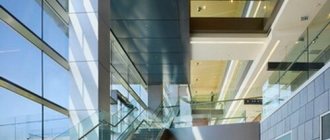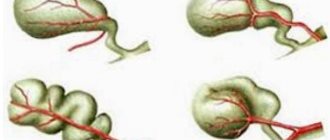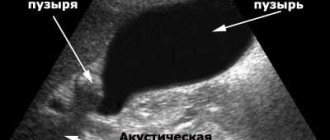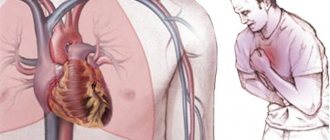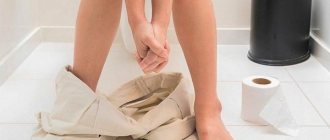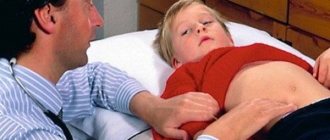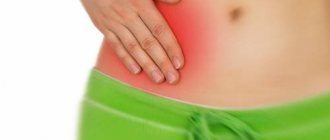The gallbladder, given its small size, is a fairly important organ of the digestive system. It is a container for bile entering it, releasing it into the intestinal lumen.
Also in this organ, resorption (reabsorption) of protein, important salts, amino acids into the blood occurs, mucus and a special hormone, anticholecystokinin, are secreted. The gallbladder can hold approximately 50 ml of fluid.
Bile is formed in liver cells, then through special bile ducts, which form a complex network, and enters the gallbladder, where it is stored until a person eats food. After food enters the duodenum, the gallbladder contracts and bile, along with pancreatic juice, moves into the intestines.
A healthy person can produce from 500 to 1000 ml of bile per day. Its composition is quite diverse: water, bile acids, inorganic substances, vitamins A, B, C, D, amino acids, phospholipids, cholesterol, bilirubin, proteins, mucus and drug residues.
The functions of bile are quite diverse:
- neutralizes gastric juice
- activates intestinal and pancreatic enzymes
- inhibits the growth of harmful bacteria in the intestines
- improves intestinal motility
- removes toxic substances and medications.
Characteristics of the main pathologies of the gallbladder
Cholelithiasis
This is a disease of the biliary system associated with a violation of bilirubin metabolism and cholesterol, characterized by the formation of stones inside the liver, in the common bile duct and in the gallbladder. There are 5F criteria for people most susceptible to cholelithiasis:
- Female – women
- Fat – overweight
- Fair - fair-haired
- Forties – over 40 years old
- Fertile - giving birth
According to the mechanism of formation, there are 3 types of stones: cholesterol, pigment bilirubin, brown and black.
Cholelithiasis can be asymptomatic for a long time, and clinically manifest itself in the form of an attack of “hepatic colic”, when the stone gets into the narrow bile duct.
Chronic acalculous cholecystitis
This is a long-term inflammatory process that affects the inner lining of the bladder and is not accompanied by the formation of stones. Main causes of the disease:
bacterial infection - intestinal microflora (Escherichia coli, enterococcus), staphylococci and streptococci, Proteus, typhoid and paratyphoid bacilli, anaerobic microflora;- parasitic infestation - cat fluke, lamblia, roundworm;
- reverse reflux of bile from the intestine is dangerous due to the pancreatic enzymes contained in it, which, when entering the bladder, begin to digest its wall; this pathology is also called chemical cholecystitis;
- allergies – food and airborne allergens;
- inflammatory diseases of the digestive system - especially hepatitis and pancreatitis have a negative effect;
- stagnation of bile.
Biliary dyskinesia
This is a functional disease of the biliary tract associated with changes in the tone of the gallbladder or ducts, accompanied by periodic pain in the right hypochondrium and dyspeptic disorders.
This pathology usually occurs under constant stress, psycho-emotional stress, and neuroses. Depending on the change in bladder tone, hyperkinetic (or pain) and hypokinetic (dyspeptic) types of the disease are distinguished.
Acute cholangitis
This is an acute inflammatory process that affects the bile ducts. It usually occurs as a complication of chronic cholecystitis, cholelithiasis or after removal of the gallbladder. The development of infection is facilitated by stagnation of bile, compression of the ducts by tumors and stones. There are obstructive, recurrent, bacterial, and secondary sclerosing cholangitis.
Gallbladder cancer
In most cases, cancer is the result of a chronic inflammatory process in the organ. There are: adenocarcinoma, mucinous, solid and squamous cell carcinoma. Gallbladder cancer is characterized by high malignancy, early metastasis and invasion into neighboring organs.
Signs of diseases of the gallbladder and biliary tract
A sign of problems is discomfort. The gallbladder hurts in women and men with varying intensity depending on the pathology that has arisen. In some pathologies there is no pain at all, while others are accompanied by severe discomfort.
The functioning of the digestive organs is impaired. Possible stool disorders (diarrhea, constipation), nausea, often accompanied by vomiting.
Bitterness appears in the mouth; similar symptoms are also characteristic of liver pathologies.
The tongue takes on a rich red color. The shade of urine also changes: since urobilinogen enters the urine, it becomes similar to dark beer. The stool, on the contrary, turns pale because the substance that colors it brown stops flowing. Jaundice develops, starting in the sclera and oral mucosa, then spreading to the skin.
If the gallbladder hurts in men or women, you should consult a doctor.
Main symptoms
| Symptom | Gallstone disease (attack of hepatic colic) | Chronic cholecystitis | Biliary dyskinesia | Acute cholangitis | Gallbladder cancer |
| Description of pain | Acute paroxysmal pain after dietary violations; the patient is on the right side with his legs pressed to his chest, any movement only intensifies the pain. | Mostly, patients are bothered by a feeling of heaviness, constant aching pain, which intensifies after consuming fatty, spicy foods, carbonated drinks, and alcohol. | Hyperkinetic type: acute short-term paroxysmal pain lasting up to 20 minutes. Hypokinetic type: dull, aching, arching pain, feeling of heaviness in the right side | Acute paroxysmal unbearable pain up to a drop in blood pressure | It may not cause pain for a long time, then dull pain appears that is difficult to relieve with analgesics. |
| Localization of pain | On the right side | In the right hypochondrium, sometimes in the epigastric region | On the right side | ||
| Radiation of pain | In the right shoulder, shoulder blade, collarbone, back, left half of the body | In the right shoulder, scapula, collarbone | In the right shoulder, shoulder blade, collarbone, back, left half of the body | In the right shoulder, shoulder blade, collarbone, back, left half of the body | In the right shoulder, scapula, collarbone |
| Dyspepsia | Repeated vomiting without relief, nausea | Nausea, vomiting mixed with bile, bitterness in the mouth, bitter belching, heartburn, loss of appetite, diarrhea, flatulence may occur. | Hyperkinetic type: nausea, vomiting. Hypokinetic type: nausea, vomiting, bowel dysfunction | Repeated vomiting without relief, nausea | Rapid weight loss, food aversions, persistent nausea, occasional episodes of vomiting |
| Itchy skin | Characteristic | Not typical | Characteristic | Not typical | |
| Fever, chills | High fever up to 40º C, accompanied by chills and heavy sweats | An inconsistent symptom, observed in 40% of patients | Low fever | High fever up to 40º C, accompanied by chills and heavy sweats | Low fever |
| Signs of peritoneal irritation | Sharply expressed in the right side | Slight tension in the abdominal muscles in the right hypochondrium | Sharply expressed in the right hypochondrium | Slight abdominal muscle tension on the right side | |
How to act during a gallbladder attack?
During the period of exacerbation, people who constantly experience biliary colic have already developed their own individual methods of treating it. Some people find it helps to switch to the right side in a supine position with a warm heating pad previously applied. Some people are saved by antispasmodic (“No-spa”) drugs, some are helped by analgesics (“Acetaminophen”), and others use all the drugs in combination.
You should immediately seek medical help in the following cases:
| № | Helpful information |
| 1 | the attack appeared for the first time |
| 2 | its duration exceeds five hours |
| 3 | the attack is accompanied by high fever and icteric manifestations in the eyes and skin |
| 4 | The pain is very severe and cannot be relieved with medications. |
Inna Lavrenko
auto RU
If attacks of this kind begin to recur frequently, and conservative treatment does not give the desired effect, then surgery to remove the gallbladder (cholecystectomy) is prescribed. And remember - it is not the attack itself that needs to be treated, but the cause of its occurrence, and such therapy can only be prescribed by a qualified doctor.
Diagnosis of gallbladder diseases
Painful symptoms of gallbladder pathology:
- Ker's point - the point of projection of the gallbladder onto the anterior wall of the abdomen - is located at the intersection of the right edge of the rectus abdominis muscle with the right costal arch;
- Georgievsky-Mussi symptom – pain when compressed between the legs of the sternocleidomastoid muscle on the right (the reference point is the inner edge of the right clavicle);
- Ortner-Grekov symptom - the occurrence of painful sensations in the right side when tapping the edge of the palm along the edge of the costal arch.
Symptoms of an attack of cholelithiasis
Hepatic colic is a common occurrence in the presence of problems with the gallbladder.
Therefore, people suffering from this type of pathology need to know how to relieve an attack of gallstone disease at home.
To do this, you should familiarize yourself with the symptoms accompanying the disease.
The initial warning signs of an exacerbation of cholelithiasis are:
- Frequent attacks of nausea.
- Heaviness in the area of the right hypochondrium.
- The appearance of a bitter taste in the mouth.
- Frequent occurrence of unpleasant sour belching.
Colic occurs from compression of the bile ducts and stones being pinched in them.
The overlap of the ducts that ensure the excretion of bile masses is diagnosed by the presence of specific acids in the blood plasma and elevated cholesterol levels. The resulting obstruction leads to the appearance of acholia and the cessation of the flow of bile secretion into the lumen of the small intestine.
Biliary colic begins unexpectedly. An attack of pain occurs when the stones are displaced and the ducts are blocked. Bile masses stagnate, damage to blood capillaries is observed, which provokes disruption of blood and lymph flow. A laboratory analysis reveals an increased content of bilirubin in the blood plasma.
Pain during exacerbation is burning, tearing and unbearable. The source of pain is concentrated in the gastric zone, while pain can radiate to the back, neck and collarbone.
To reduce pain, it is recommended to use painkillers for gallstone disease. Without the use of these drugs, noticeable tension appears, as well as bloating in the right side of the upper quadrant of the abdomen. In addition, discomfort appears even with a light touch.
Attacks can have varying durations - from 2-3 minutes to several hours. In some cases, pain can last for several days. After the end of the acute period, lethargy and weakness appear for 2-3 days.
Changes in laboratory parameters in diseases of the biliary system
| Index | Norm | What is he talking about? | What diseases does it indicate? |
| An increase in the level of total bilirubin due to unbound |
| More often indicates a violation of the outflow of bile (obstructive jaundice) | Cholelithiasis, cancer of the gallbladder, common bile duct, papilla of Vater, acute cholangitis, chronic cholecystitis, etc. |
| An increase in the level of total bilirubin due to bound |
| Indicates decreased conjugation (binding) of bilirubin | Hemolytic anemia, Minkowski-Choffard disease, Gilbert's syndrome, Crigler-Najjar syndrome |
| Increased levels of transaminases (AST and ALT) |
| Talks about the inflammatory process and destruction of liver cells | Hepatitis, cholelithiasis, chronic cholecystitis, gallbladder cancer |
| Increased cholesterol levels in the blood | 3.3-5.5 mmol/l | Indicates increased fat metabolism | Vascular atherosclerosis, obesity, cholelithiasis, chronic cholecystitis |
| Reducing blood cholesterol | 3.3-5.5 mmol/l | Indicates a decrease in the building function of the liver | Acute hepatitis, acute cholangitis, acute cholecystitis, liver cirrhosis, liver and gall bladder cancer |
| Increased alkaline phosphatase activity | 0.5-1.3 mmol/h*l | Indicates stagnation of bile in the liver and bladder | Gallstone disease, chronic cholecystitis |
| Appearance of C-reactive protein | not detected | Speaks of an acute inflammatory process | Acute cholecystitis, cholelithiasis, acute cholangitis |
Instrumental methods for diagnosing diseases of the biliary system
| Diagnostic method | Cholelithiasis | Chronic cholecystitis | Biliary dyskinesia | Acute cholangitis | Gallbladder cancer |
| Ultrasound of the abdominal organs | Stones, gall sand, and “porcelain” gallbladder are detected | Thickening, deformation of the gallbladder wall, signs of inflammation |
| Signs of hypertension in the bile ducts, their expansion | Increasing bubble density |
| Fractional duodenal intubation | Decrease in the amount of gallbladder bile, changes in the biochemical composition of bile, presence of bacteria |
| Decrease in the amount of gallbladder bile, changes in the biochemical composition of bile, presence of bacteria | Tumor cells are found in bile | |
| Radiography | Calcium-containing stones are detected | Thickening, deformation of the gallbladder wall, signs of inflammation | No changes | Not used | When using contrast, a filling defect with uneven contours is revealed |
| CT scan | Used as an additional research method to make a diagnosis | Used to detect metastases and tumor growth into neighboring organs | |||
| ECG | Performed to exclude acute infarction of the posteroinferior myocardial wall | ||||
| Fibrogastrodudodenoscopy | Superficial gastritis | ||||
Diagnostics
An experienced gastroenterologist will be able to distinguish a mild spasm from hepatic colic by the appearance of the patient. Instrumental diagnosis is based on the use of ultrasound of the biliary tract. In addition, X-ray examination and cholecystography are performed.
Diagnosis of cholelithiasis is based on three main signs:
- Attacks of biliary colic.
- The presence of stones in the gallbladder, identified using instrumental studies.
- Detection of crystals of a certain chemical composition during duodenal intubation.
Tests are prescribed to help establish the etiology: a biochemical study of blood and bile, a coprogram to identify parasites.
How to relieve a spasm in the gallbladder - self-help options
You should unfasten the buttons on your clothes and loosen your belt. It is recommended to lie down or take a warm bath. It is contraindicated to apply a hot heating pad or a warming compress.
You can try to relieve gallbladder spasm yourself. Fasting is beneficial, but eating increases discomfort.
If a visit to the doctor or calling a doctor at home is postponed, then take antispasmodic and/or painkillers. Combination medications are available (antispasmodic + analgesic).
Become familiar with dosages, contraindications and side effects in advance. Drug manufacturers provide this information in their instructions.
The combined drugs Spazmalgon, Spazgan, Bral relieve pain and spasm. Combinations of substances are selected so that the effect is mutually enhanced. However, the concentration of active ingredients is lower than in individual medications.
Therefore, one tablet replaces two, one injection replaces two injections. The drug load on the body is reduced without reducing the therapeutic effect.
You cannot choose and take pills on your own in case of an “acute abdomen”, when severe pain is localized mainly on the right, below or above the waist. Taking an anesthetic “blurs” the picture of the disease, although the patient’s condition is life-threatening.
Principles of treatment
Diet No. 5 (see in more detail what you can eat with cholecystitis and gallstones).
- food is taken 4-6 times a day in small portions
- warm drink: weak tea, juices from fruits and berries diluted with water, rosehip decoction 3-6 glasses a day
- porridges: semolina, oatmeal, rice
- vegetable soups
- lean fish and meats
- dairy products: cottage cheese, sour cream, fermented baked milk, butter
- vegetable fats
Cholelithiasis
- bed rest
- Diet No. 5 – excluding fatty, high-calorie and cholesterol-rich foods
- normalization of body weight
- ursodeoxycholic acid preparations: ursofalk, ursosan, ursolizin, choludexan (to improve the outflow of bile)
- antibacterial therapy - 3-4 generation cephalosporins (Fortum, cefotaxime, cefazolin) or aminoglycosides (tobramycin, amikacin) or fluoroquinolones (ciprofloxacin, levofloxacin)
- myotropic antispasmodics (mebeverdine, duspatalin) – to relieve muscle spasms during colic
- hepatoprotectors – for the prevention of reactive hepatitis (Essentiale, Heptral, see the full list of medications for the liver)
- narcotic and non-narcotic analgesics – nalbuphine, ketanov, promedol
For frequently recurring attacks of hepatic colic, surgical treatment is indicated - removal of the gallbladder (cholecystectomy).
Chronic cholecystitis
- Diet No. 5 – excluding fatty, high-calorie and cholesterol-rich foods
- bed rest for 7-10 days
- broad-spectrum antibacterial drugs: 3-4 generations (Fortum, cefotaxime, cefazolin) or aminoglycosides (tobramycin, amikacin) or fluoroquinolones (ciprofloxacin, levofloxacin)
- myotropic antispasmodics (mebeverdine, duspatalin) – to relieve muscle spasms during colic
- enzyme preparations - Creon, Pancreatin, Festal, Panzinorm, Enzistal, Penzital, Ermital, Mezim, Gastenorm, Microzim, Pangrol, etc.
- antisecretory drugs: Almagel, Maalox, Omez, Controloc, rhinitis, Kvamatel
Biliary dyskinesia
- eliminating stressful situations, taking antidepressants and sedatives (see sedatives for adults)
- diet No. 5
- drugs that eliminate bladder muscle spasms - no-spa, papaverine, drotaverine, mebeverdine
- herbal preparations: arnica, elecampane, oregano, immortelle, calamus and others
- choleretic drugs – magnesium sulfate, sorbitol, holagol, allochol, digestal
- physiotherapeutic procedures – inductothermy, diadynamic currents, UHF
Acute cholangitis
- broad-spectrum antibiotics: semi-protected penicillins (amoxiclav), 3-4 generation cephalosporins (ceftriaxone, cefepime), fluoroquinolones (moxifloxacin, gatifloxacin)
- myotropic antispasmodics (mebeverdine, duspatalin) – to relieve muscle spasms during colic
- enzymes - Festal, Mezim, Creon, etc. see above.
- antipyretic drugs - paracetamol, acelysin, infulgan
- narcotic and non-narcotic analgesics – nalbuphine, ketanov, promedol
Treatment and prevention
You should consult a doctor as soon as warning signs of the disease appear. After diagnosis, the doctor will prescribe drug therapy if we are talking about cholecystitis, cholangitis, dyskinesia. Choleretic drugs are usually indicated, and a diet is required. It is also the prevention and treatment of such diseases.
Traditional medicine also helps - immortelle, yarrow, and nettle are good for treating the gallbladder, improving the outflow of secretions and relieving inflammation. Painkillers and antispasmodics are also indicated. For inflammatory processes, an antibiotic is prescribed.
But in case of cholelithiasis, polyps and cancer, surgical treatment of the gallbladder is performed, that is, its removal.
In each case, the surgeon makes an informed decision based on the patient’s complaints and examination data. There is no such drug that treats gallstones in these cases.
Prevention of pathologies of this organ consists of only one thing: a healthy lifestyle, proper and regular nutrition, exercise, and timely consultation with specialists in case of illness. As practice shows, most of the disorders in the functioning of the gall bladder are caused by alcohol abuse, fatty foods, and lack of exercise, so it is worth reconsidering your lifestyle if you do not want to find out from your own experience what gallstone disease is.
